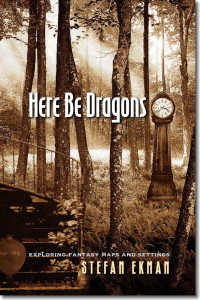 I’ve been working on my post on Ursula Le Guin’s Earthsea series, which has a rich imaginary geography, and which naturally has a map of its world, as created by its creator, which you can see here. There are equally famous maps, say that of Frank Herbert’s Arrakis or that of J.R.R. Tolkien’s Middle-earth. Some maps remain only in the mind of the reader, such as the one for Emma Bull’s post-apocalyptic Minneapolis in her Bone Dance novel or the city of Newford in the works of Charles de Lint.
I’ve been working on my post on Ursula Le Guin’s Earthsea series, which has a rich imaginary geography, and which naturally has a map of its world, as created by its creator, which you can see here. There are equally famous maps, say that of Frank Herbert’s Arrakis or that of J.R.R. Tolkien’s Middle-earth. Some maps remain only in the mind of the reader, such as the one for Emma Bull’s post-apocalyptic Minneapolis in her Bone Dance novel or the city of Newford in the works of Charles de Lint.
Now we have a really detailed look at the role of fantasy maps and the settings they help create in fantasy literature. (Though weirdly enough, Here Be Dragons has only three such maps in it suggesting the author either had trouble getting permission to use more such maps or the use of them was deemed too costly.) It is not the usual collection of edited articles but appears an actual cohesive look at this fascinating subject.
I as a Librarian have an abiding interest in fantasy maps and lecture my Library apprentices, the girls I call collectively the Several Annies, on that subject often, including the maps of Tolkien. Until now, I’ve lacked a good book on the subject but Here Be Dragons will do very nicely.
It is the first in-depth study I know of on the use of landscape in fantasy fiction, and Ekman notes that landscape is often as important as the characters and plot in creating a coherent and believable story. Though he focuses quite naturally on the geography of Tolkien’s fiction, he doesn’t overlook other works such as Charles de Lint’s urban landscape of Newford, Robert Holdstock’s Ryhope Wood in his series of the same name, Pratchett’s Discworld, and China Miéville’s alien landscape of New Crobuzon. (I’d have given a pretty penny to see him explain the perceptual geography of Miéville’s The City & The City!) I’m only touching on a few of the many, many fantastic cartographies he mentions in the course of trying (successfully I’d say) to provide his own map to this complex subject as he looks at landscape within the fiction of such writers as Neil Gaiman, Garth Nix, Michael Moorcock, Patricia McKillip, Steven Brust, Tim Powers, Lisa Goldstein, Steven Donaldson, Robert Jordan, and Charles Vess.
I admit the inclusion of Vess surprised me and it’s actually a bit of stretch as he’s really talking about Neil Gaiman’s Stardust novel of which one version is illustrated by Vess. The novel sans illustrations is very fussy on geography.
So the bottom line is that if you’re really really interested in fantasy geography, this is worth reading. But I will stress that its dense enough reading that I can hear the future mutterings of the Several Annies who are going to read this tome.
(Wesleyan, 2013)
